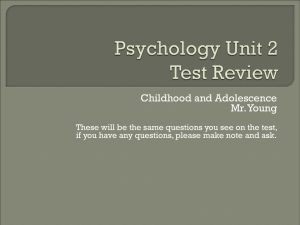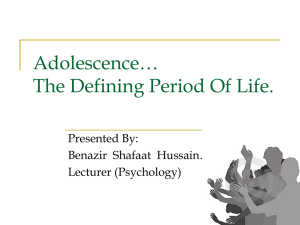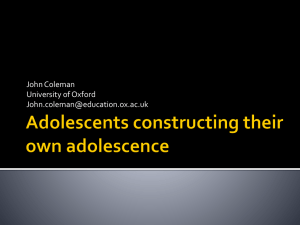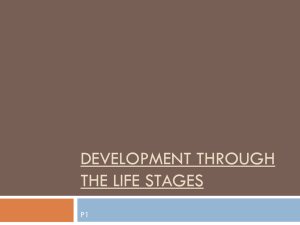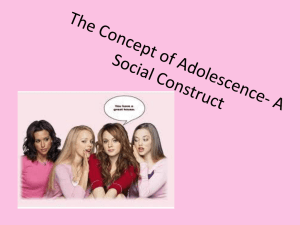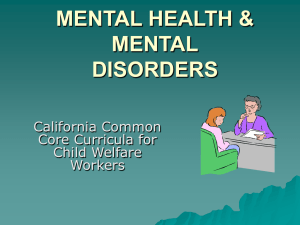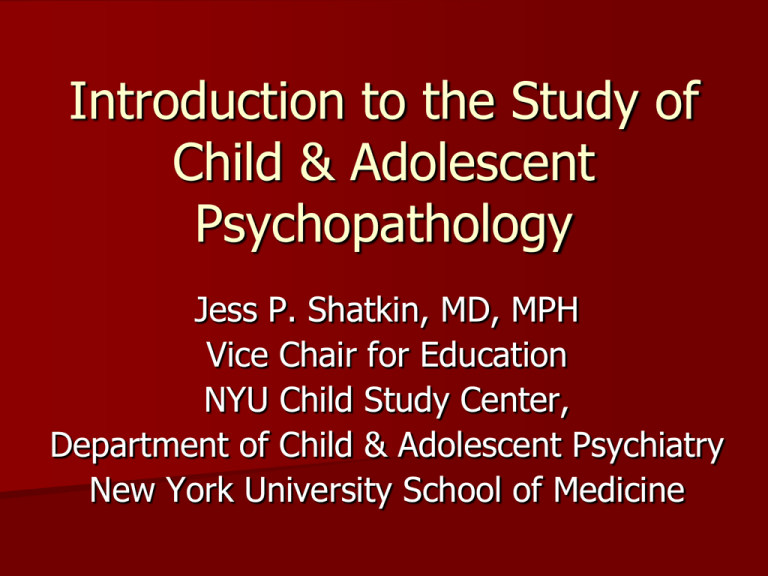
Introduction to the Study of
Child & Adolescent
Psychopathology
Jess P. Shatkin, MD, MPH
Vice Chair for Education
NYU Child Study Center,
Department of Child & Adolescent Psychiatry
New York University School of Medicine
“When I was a boy of 14, my father
was so ignorant I could hardly stand
to have the old man around. But
when I got to be 21, I was
astonished at how much he had
learned in seven years.”
--Mark Twain
(1835 – 1910)
Learning Objectives
Residents will be able to:
1. Describe the relative neglect that child
and adolescent mental health has
historically suffered as a field.
2. Identify various theories of normal child
development, risk factors for child mental
illness, and sex and socio-cultural
differences responsible for mental
wellness and illness.
3. Explain the health paradox of
adolescence.
Why study child & adolescent psychopathology?
High prevalence of mental health problems among
adolescents and young adults; estimated at 20% by
Surgeon General’s Report of 1999.
Is this due to better diagnosis, an actual increase in
prevalence, or both?
Half of all lifetime cases of mental illness are now
recognized to begin by age 14 and three-quarters by
age 24 (Kessler et al, 2005).
The median number of years from the time a child first
experiences psychiatric disturbance and receives
treatment is 9 years (2 years for psychotic illnesses);
Kessler et al, 2005
Despite effective treatments, however, there are
typically long delays, sometimes decades, between
when individuals first experience clinically significant
symptoms and when they first seek and receive
treatment.
What kind of numbers
are we talking?
Severe, disabling depression affects
approximately 17% of adolescents and young
adults nationally (Kashani & Sherman, 1988;
Fleming & Offord, 1990; Lewinsohn et al, 1993
& 1994; Kessler & Walters, 1998)
Anxiety in its many forms results in significant
impairment in approximately 13% of children
and adolescents (Shaffer et al, 1996).
Attention Deficit-Hyperactivity Disorder (with a
prevalence of 3 – 7%) and Bipolar Mood
Disorder (with a prevalence of over 1%), and
others affect smaller numbers but are
ubiquitous
What kind of numbers
are we talking? (2)
Despite the fact that federal government
spending on anti-drug measures has increased
over ten-fold in the last 15 years, over 50% of
high school seniors have experimented with an
illicit drug, 23% have used an illicit drug within
the past 30 days, and over 30% have been
drunk within the past 30 days (Johnston et al,
2005).
Suicide, the most feared and tragic outcome of
mental illness, is the third most common cause
of death among adolescents and young adults,
preceded only by accidents and homicide
(Anderson and Smith, 2003).
Who gets help?
The population of children and adolescents under
age 20 is projected to grow by about 33 percent in
the next 40 years from about 84 million to 112
million by 2050 (U.S. Bureau of the Census, 2010).
Fifteen million children in the U.S. have diagnosable
psychiatric or learning disorders but nearly 70%
don't receive the help they need
Who receives services?
– 1 in 3 Caucasian kids
– 1 in 5 African American kids
– 1 in 7 Latino kids
Fewer than 10% of the 80,000 public schools in the
U.S. have comprehensive mental health services
What do we know
about these problems?
Epidemiology is important but etiology is vital
Basic research and clinical investigation are needed
to understand the neurobiological basis of mental
illness
The tragedy is that we most often do not know the
“best” treatment and for whom various treatments
will be most accurately provided
The growth in evidence-based treatments,
including medications and psychotherapies,
increasingly allows us to treat specific symptoms in
a replicable fashion
Who does this work?
Mental health practitioners who treat children and
adolescents are in short supply.
The United States’ Federal Bureau of Health
Professions has named Child and Adolescent
Psychiatry as the most underserved of all medical
subspecialties. The current workforce consists of
approximately 6300 Child and Adolescents
psychiatrists (Thomas and Holzer, 2006), whereas
the need has been estimated to be as high as
32,000 (AACAP, 2001).
Child and Adolescent Psychiatrists are not alone,
however, as the national need for child and
adolescent social workers, educational specialists,
and psychologists is equally as great.
Present Supply of Child and Adolescent
Psychiatrists
There are currently about 7,000 child and adolescent
psychiatrists practicing in the U.S. (AMA, 2010).
Severe maldistribution of child psychiatric services in the
U.S., with children in rural areas and areas of low SES
having significantly reduced access.
The ratio of child and adolescent psychiatrists per 100,000
youth ranges from 3.1 in Alaska to 21.3 in Massachusetts
with an average of 8.7 (Thomas & Holzer, 2006).
The number of child and adolescent psychiatrists will
increase by about 30 percent to 8,312 by 2020. This is far
less than the estimated 12,624 needed to meet demand.
So, who really does this work?
The vast majority of child and adolescent mental
health services worldwide are provided by primary
care practitioners, psychologists, and all manner of
therapists, ranging from masters level social
workers to marriage and family therapists.
Nearly 85% of all psychotropic medications
prescribed to children, including stimulants,
antipsychotics, antidepressants, anxiolytics, and
mood stabilizers, for example, are written by
primary care practitioners (Goodwin et al, 2001).
Yet these individuals generally receive no formal
training in child and adolescent mental health
(ACGME(b), 2007).
What does a child/adolescent
psychiatrist do for a living?
Works with children, adolescents, and
families who have problems with their:
– Emotions
– Behavior
– Cognition/thinking
Books
Historical Perspective
Valuing children in their own right has not been a
priority of earlier societies
“Childhood” itself is really an invention of the Victorian
Age (mid-1800s onward)
Prior to the 18th century, children’s mental health
problems (unlike those of adults) were rarely mentioned
in professional texts and communications
During this time, virtually all etiologies for disordered
behavior in children were based upon religious
explanations (and magic to a lesser degree)
The separation between medicine, science, religion, and
magic was virtually nonexistent
Humoral Theory
Until the mid-1880s, the predominant theory
used to explain all health problems
Based upon the tradition of Galen, a 2nd
century Greek physician
Disease followed an excess in the production
of any one of the four humors: Blood,
yellow bile, black bile, & phlegm
Physiologic imbalances that
resulted were treated by nonspecific therapies (e.g., bleeding
and purging)
“Official” Child Maltreatment
During the 17th – 18th centuries, as many as 2/3
of children died before their 5th birthday
Many children were also subjected to harsh
treatment or indifference by their parents
Children were essentially the property of their
parents
Massachusetts’ Stubborn Child Act of 1654
permitted parents to put “stubborn” children to
death for noncompliance
Until the mid-1800s, the law allowed children with
severe developmental disabilities to be kept in cellars
and cages
The Emergence of
Social Conscience
In the West, this process began in the 17th century
when both a philosophy of humane care and
institutions for social protection began to take root
(following on industrialization)
John Locke (1632 – 1704), an English philosopher,
believed in individual rights and expressed the
novel opinion that children should be raised with
thought and care rather than indifference and
harsh treatment
Victor: The Wild Boy
of Aveyron
One of the first documented efforts to work with a
special child was undertaken by Jean-Marc Itard
(1775 – 1838)
Victor was discovered by hunters in the woods of
France at 11 – 12 years of age, having presumably
lived alone all his life (or at least since age 2-3)
He was nonverbal, inattentive, and insensitive to
basic sensations (hot & cold)
Itard believed that environmental stimulation could
“humanize” Victor, but he was never fully
socialized
Philippe Pinel
1745 - 1826
The father of French psychiatry
Discarded the long held notion of mental illness being
due to demoniacal possession
Began to classify his observations of the mentally ill
Developed “moral treatment” and the first efforts at
psychotherapy
Physician to Napoleon
Benjamin Rush
(1746 – 1813)
Physician, educator, writer, humanitarian
B&R in Philadelphia, his practice was aimed at providing
care for the poor
He advocated for the abolition of slavery and signed the
constitution
His greatest contributions to medical science were the
reforms he instituted in the care of the mentally ill during
his thirty years of service as a senior physician at the
Pennsylvania Hospital; he was more compassionate than
was typical and replaced routine reliance on archaic
procedures with careful clinical observation and study
The year before he died, he published Medical Inquiries and
Observations upon the Diseases of the Mind, the first
American textbook on psychiatry
Dorothea Dix
(1802 – 1887)
A teacher and social reformer for the
treatment of the mentally ill. She
established 32 humane mental hospitals for
the treatment of troubled youth previously
relegated to cellars and cages.
She is somewhat neglected in the history
books because she did not contribute to our
understanding of the nature of mental
disorders
The Brief Emergence of a
Biological Paradigm
Successful treatment of infectious diseases strengthened
the emerging belief that illness and disease (including
mental illness) were biological processes
Although the mental effects of some “biological” diseases
came to be recognized (e.g., syphilis, Huntington’s, etc.),
still little could be done to help those with mental illness and
early attempts at biological explanations of mental illness
were still biased in locating the cause of the illness within
the individual
Consequently, once again attitudes toward those with
mental illness turned from cautious optimism to dire
pessimism, hostility, fear and disdain
During this time (the late 19th and early 20th centuries),
emerging ideas around public health and medicine were
essentially used against the mentally ill, including eugenics
(sterilization) and segregation (institutionalization) to
prevent the “insane” from interacting with the rest of
society
Psychoanalytic Theory
In Freud’s day (the beginning of the 20th century)
child psychiatrists and psychologists had become
pessimistic about their ability to treat children’s
mental disorders in a fashion other than palliative
or custodial
Although he believed in innate drives and
predisposition (or that the origin of most mental
illness was biological), he also believed in the
importance of experience in the shaping of
psychopathology; he was the first to give meaning
to mental disorders by linking them to childhood
experiences
For the first time, the course of mental disorders
was not seen as inevitable
Structural Theories of Development
Postulate a genetically determined capacity for the
development of patterns, or systems, of behavior in
which the child acts on the environment from the
very beginning
Major examples include psychoanalysis (Freud),
psychosocial development (Erikson), and cognitive
development (Piaget)
The clinical implication of such structural theories is
that some kind of reorganization within the child is
required (e.g., resolution of an intrapsychic conflict,
alteration of the family homeostasis, and
acquisition of a new schema) to develop
Freud’s Drive Theory
Aggressive and sexual “drives” are the primary
motivating forces in our quest for pleasure
The end goal of development is sexual maturity;
five stages are defined:
1. Oral Phase (Infancy, birth to 18 months)
2. Anal Phase (aka: Sadistic Phase, 18 – 36
months)
3. Phallic-Oedipal Phase (3 – 6 years)
4. Latency Phase (6 – 12 years)
5. Puberty and Adolescence
Mahler’s Separation/Individuation
Mahler’s intent was not to add new theory but to systematically
observe and detail the unfolding of object relations in children
and infants
– Objective Relations is a more “modern” adaptation of
psychoanalytic theory that places less emphasis on the drives
of aggression and sexuality as motivational forces and more
emphasis on human relationships as the primary motivational
force in life; in other words, we seek relationships rather than
pleasure (as Freud suggested).
Six stages of development lead to normal object relations,
predicated upon a recognition of “separateness”:
1. Normal Autism (birth to 2 months)
2. Symbiosis (2 – 5 months)
3. Differentiation (5 – 10 months)
4. Practicing Sub-Phase (10 – 18 months)
5. Rapprochement (18 – 24 months)
6. Object Constancy (2 – 5 years)
Erikson’s Psychosocial Development
A psychoanalytic theory comprising 8 stages,
where “normal” development hinges upon
successfully traversing 8 dichotomies:
1.
2.
3.
4.
5.
Basic Trust vs. Mistrust (Birth to 1 year)
Autonomy vs. Shame and Doubt (1 – 3 years)
Initiative vs. Guilt (3 – 5 years)
Industry vs. Inferiority (6 – 11 years)
Identity vs. Role Diffusion (11 years – end of
adolescence)
6. Intimacy vs. Isolation (21 – 40 years)
7. Generativity vs. Stagnation (40 –65 years)
8. Integrity vs. Despair (over 65 years)
Bringing Analytic Theory to Children
Anna Freud (1895 – 1984) was particularly
important in expanding Freud’s ideas to
children
Melanie Klein (1882 – 1960) argued that
children’s play could be interpreted in terms
of unconscious fantasy
Their combined work led to the development
of child psychoanalysis and a recognition of
the importance of nonverbal communication
(e.g,. play, drawings, etc.)
Piaget and Cognitive Development
Piaget identified 4 major stages of
cognitive development:
1. Sensorimotor Stage (birth to 2 years)
2. Preoperational Stage (2 to 7 years)
3. Concrete Operational Stage (7 years to
adolescence)
4. Formal Operational Stage (adolescence)
The Emergence of Behavioral Theory
The development of “evidence based”
treatments in mental health is traced to
behavioral theory
Early investigators’ (e.g., Pavlov, Skinner, and
Watson) experimental research established the
foundations of conditioning
As evidence mounted, current treatments were
questioned, including the use of orphanages.
The increasing data for behavioral treatments led
to increasing acceptance of these treatments,
which by the 1970s had become (and remain)
more the norm than the exception
What is normal?
Is it the converse of abnormal?
When does an “issue” become a problem?
Why do some children struggle more than
others with the same symptoms or
diagnosis?
What accounts for the waxing and waning
of symptoms over time?
How can you help an abnormal child
become normal?
“All happy families are
happy alike, all unhappy
families are unhappy in
their own way.”
--Leo Tolstoy
Anna Karenina
1877
Defining Psychological Disorders
A pattern of behavioral, cognitive,
emotional, and/or physical symptoms
shown by an individual
Characteristics must include:
–
–
–
Distress
Disability
Risk of further suffering or harm
Developmental Pathways
Multifinality: Various outcomes may stem
from similar beginnings
Equifinality: Similar outcomes may follow
from different early experiences
Risk Factors
A variable that precedes a negative
outcome and increases the chance of that
outcome occurring
Primary risk factors for child
psychopathology include: poverty,
inconsistent care giving, parental mental
illness, death of a parent, homelessness,
family break up, early pregnancy, neonatal
complications, etc.
Resilience Factors
A variable that increases one’s ability to
avoid negative outcomes despite a risk for
psychopathology
A much more difficult factor to categorize
and may change over time depending
upon the child and the environment;
individual, family, and social factors will all
have an impact
How Are Children Faring Today?
1 in 6 children live in poverty in the U.S.
and Canada
1 in 3 children will be “poor” at some point
during childhood
Low income is correlated with other
disadvantages:
– Less education, lower paying jobs, inadequate
healthcare, singe-parent status, limited
resources, poor nutrition, greater likelihood of
exposure to violence
Maltreatment &
Non-Accidental Trauma
Nearly 1 million verified cases of child abuse
occur in the U.S. each year and 60,000 in
Canada
U.S. phone surveys of children 10 – 16 y/o
estimate that over 1/3 (6 million) have
experienced physical and/or sexual assaults
during these years; not only by family
members but also by people they may know
from their communities and schools
The Effect of Poverty
Children from poor and disadvantaged
backgrounds show 3x the rate of Conduct
Disorder, 2x the rate of chronic illness, and
>2x as many school problems (including
hyperactivity and emotional disorders)
The worse the poverty, the higher the
incidence of childhood violence (3x greater
in girls, 5x greater in boys)
Sex Differences
Girls
– More internalizing problems:
anxiety, depression, somatization, withdrawal
– Girls who display resilience come from
households that combine risk taking and
independence with support from a female
caregiver (e.g., mother, sister, grandmother,
etc.)
Sex Differences
Boys
– More externalizing problems:
aggression, delinquency
– Boys who display resilience come from
households in which there is a positive male
role model (e.g., father, older brother,
grandfather, etc.) along with structure, rules,
and some encouragement of emotional
expression
Sex Brain Differences
Men tend to use 7,000 words on average per
day and women tend to use 20,000 words
on average per day
Beginning in the teen years, females may get
a larger dopamine “rush” from talking (and
gossiping) than males (likened to an
orgasm?)
By 8 weeks in utero, testosterone produced
by the testes begins to lead to enlargement
of the amygdala where aggression behaviors
appear to be housed
Sex Brain Differences (2)
Female babies are more interested in faces
and boys more interested in objects
Female babies increase their visual interest
in faces by 400% in the first 3 months of
life; whereas males demonstrate no change
by 3 months
Girls’ brains mature about 20% faster than
boys’ until the mid-teen years (e.g., girls
tend to develop language quicker, toilet train
earlier, etc.)
Brizendine, 2006
Race and Culture
Minority children are overrepresented in some
disorders (e.g., SUDS, delinquency, teen suicide);
but once SES, gender, age, and referral status are
controlled for, very few differences in the rate of
children’s psychological disorder emerge
Certainly the barriers to receiving and accessing
care are greater among racial minorities and some
cultures
Racial and ethnic minorities are also neglected in
studies; and most research into childhood
psychopathology is not based upon diverse
populations
The Health Paradox of Adolescence
Adolescence (15 – 24 y/o) is the physically
healthiest time of life prior to adult declines
– Improvement in strength, speed, reaction time,
reasoning and immune function
– Increased resistance to extremes of heat, cold,
hunger, dehydration, and most types of injury
Yet overall morbidity and mortality rates
increase by 200-300% between late
childhood (10 – 14) and adolescence (15 –
19)
Why???
Primary Sources of
Mortality in Teen Years
The primary reasons for the increase in
mortality and morbidity seen in
adolescence are related to control of
behavior, cognition, and emotions
The most common causes of death in
adolescence are:
1. Accidents
2. Homicide
3. Suicide
LEADING CAUSES OF DEATH
IN 15- TO 19-YEAR-OLDS
— U N I T E D S T A T E S, 2001 —
CAUSE
# OF DEATHS
Accidents
Homicide
Suicide
Cancer
Heart Disease
Congenital Anomalies
Chronic Lower
Respiratory Disease
Stroke
Influenza and Pneumonia
Blood Poisoning
Anderson & Smith 2003
6646
1899
1611
732
347
255
74
68
66
57
1599
C.E14
Teenage Morbidity
Depression increases from a 4%
prevalence in childhood to around 17% in
adolescence (lifetime prevalence)
Substance abuse, eating disorders,
psychotic disorders, etc, all increase
greatly during teen years and lead to
major increases in morbidity approaching
(or reaching) adult levels
Risk Taking Behavior
Adolescence also heralds high rates of risk
taking behavior, sensation-seeking, and
erratic, emotionally influenced behavior
How old were Romeo and Juliet?
How well did Romeo and Juliet know each
other?
What Happens in Adolescence?
Increase in:
– Responsibility
– Academic demands
– Negative life events
– Alone time
– Friction between expected & actual life events
– Ability to abstract
– Intimate relationships
So, why the increase in
risk taking behavior?
Darwinian argument: You need to become
more of a risk taker and sensation seeker
and adventurer when you strike out on your
own and leave your safe home environment
in order to survive
Peer pressure
Brain development: “Adolescence is like
starting the engines with an unskilled
driver.”
Ron Dahl
The Risky Brain
Cognitive development (e.g., planning,
reasoning, problem solving, logic, etc.)
correlates more strongly with age and
experience than with sexual and physical
maturation
While motor tracks are fully mature by
about 15 – 16 y/o, cognitive tracks may not
be fully developed until the mid-20s, and
social/emotional tracks until the mid-30s
Ventral Striatum vs. Prefrontal
Growth and Functional Connectivity
“Adolescent brain development represents a tension between early emerging
‘bottom up’ systems that express exaggerated reactivity to motivational
stimuli and later maturing ‘top down’ cognitive control regions.”
Casey & Jones, 2010
Cerebral Blood Flow
The Prefrontal Cortex
The PFC, which can act to inhibit impulsive,
motivational drives is still somewhat
immature in adolescents. When DA
increases in the nucleus accumbens and a
pleasure response occurs in the limbic
system, an adolescent may have little ability
to inhibit the motivation to seek out
pleasurable responses, such as substance
abuse or sex; or to sit still instead of being
easily distracted by anxiety; or to take
cognitive control of depressive thoughts
Other Factors Affecting the Brain
During Adolescence
Hormones
Pruning of serotonin circuits may lead to
an increase in impulsivity
Common maladaptive behaviors of
adolescence, which also contribute to
impairment in judgment:
– Less sleep
– Caffeine use
– etc
So, how do we know when
there is a problem?
or
How do we know when a
problem demands treatment?
What’s in a Diagnosis?
How does a diagnosis help you?
How would you develop a diagnostic
system?
The Broken Arm
Nosology
DSM-I (1952)
All “disorders of psychogenic origin or without clearly
defined physical cause” were considered “reactions”
– Schizophrenic reaction
– Antisocial reaction
– Psychoneurotic reactions included:
Anxiety reaction, Dissociative reaction, Conversion reaction,
Phobic reaction, Obsessive compulsive reaction, Depressive
reaction
Following upon Freud’s emphasis on the importance of
mastering anxieties generated by characteristic
conflicts at identifiable stages of psychosexual
development (and attributing psychopathology to
failure to resolve these conflicts), it was implied in the
DSM-I, if not specifically stated, that anxiety was at the
core of all diagnoses
DSM-II (1968)
Provided brief descriptions of
characteristic signs and symptoms of the
disorders but no criteria as such
In 1973, during the 6th printing of the
DSM-II, homosexuality was finally
removed
DSM-III (1980)
A similar approach to the DSM-II was followed
here; but now diagnostic criteria for the various
disorders were provided
Better inter-rater reliability and evidence of
predictive reliability
Specified a group of disorders as “usually first
evident in infancy, childhood, or adolescence”
– Reactive attachment disorder, separation anxiety
disorder, overanxious disorder, and avoidant disorder
– Additionally, the anxiety diagnoses applicable to adults
were available for diagnosing children
DSM-III-R (1987)
Both the DSM-III and the DSM-III-R were criticized
by some researchers, particularly regarding
childhood diagnoses, due to limited evidence of
validity
Many clinicians of the psychodynamic tradition
objected to the atheoretical approach of the DSM-III
and to the elimination of the term neurosis
– Theoretical considerations were discarded in favor of
diagnostic reliability
– This approach contributed to the subsequent flourishing of
evidence-based research
– Since this time, diagnostic criteria have been increasingly
put to the test and retained, removed or reconceptualized
DSM-IV Diagnoses
DSM = Diagnostic and Statistical Manual of
the American Psychiatric Association
“Statistical” because a given number of
symptoms are necessary to make a
diagnosis
Diagnoses are phenomenological or
symptom driven and may be the result of
biological, psychological, and social factors
Axis System
Axis I
– Clinical mental disorders
– V codes (a focus of clinical attention, but not a
proper diagnosis)
Parent/child relational problems
Sibling relation problems
Child abuse or neglect, etc.
Axis II
– Personality Disorders
– Mental Retardation
– issues that affect all aspects of an individual’s
functioning (global impact on all aspects of the
individual’s life)
Axis System (2)
Axis III
– Major medical diagnoses
Axis IV
– Psychosocial and environmental issues (aka,
“stressors”) that contribute to the disorder
Axis V
– Global Assessment of Functioning (GAF)
– a numeric scale (0 through 100) used to rate
social, occupational and psychological functioning


